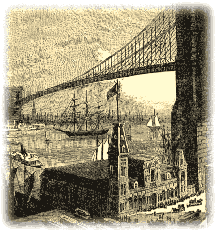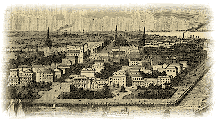US History 8th Grade Themes, Examples, Definition and Description - 1763-1877
What Do They Mean? Thats what the following paragraphs will explain.
Theme 1: The movement of people, the spread of cultures and technological innovations of diverse groups and visionaries fueled the growth of America. (Civilization, Cultural Diffusion, and Innovation)
 A major theme in history is civilization, cultural diffusion and innovation; these concepts deal with the spread of tools, machines, traditions, lifestyles, laws, practices and ideas. To understand history we need to look at how groups of people have interacted, their goals, tools and inventions. Teachers of social studies must help students recognize the fluid interplay between different groups and the struggle to maintain a group identity while absorbing and accommodating change. Often once an idea has been unleashed it cannot be contained and frequently causes an unanticipated transformation---the process of diffusion.
A major theme in history is civilization, cultural diffusion and innovation; these concepts deal with the spread of tools, machines, traditions, lifestyles, laws, practices and ideas. To understand history we need to look at how groups of people have interacted, their goals, tools and inventions. Teachers of social studies must help students recognize the fluid interplay between different groups and the struggle to maintain a group identity while absorbing and accommodating change. Often once an idea has been unleashed it cannot be contained and frequently causes an unanticipated transformation---the process of diffusion.
Human groups continually influence each others lifestyles, whether by intention or not. For example, Europeans used technology to explore and trade. Their values and interactions effected Native Americans, forever changing the lifestyle of native peoples. A prohibition against reading and writing by enslaved Africans was once used to dominate African Americans, yet it has become an important means of expression of African American culture. Political rights, originally reserved only for white male property owners, once unleashed, could not be denied to women and minorities.
The spread and use of ideas, technology and innovations causes people to change and evolve. The Erie Canal brought a rich flood of mew people who spread their cultures and innovative ideas to ever-widening geographic spheres.
Benchmark Alignment: II.2MS4, II.2MS5, II.5MS1, IV.2MS2, IV.4MS1
Theme 2: The development and expansion of the United States was driven by the relationship between location, natural resources, climate and the cultures of the people who settled North America. (Human Interaction with the Environment)
Humans influence each other, just as they interact with the natural environment. Events in history need to be seen in light of the struggles of humans to master nature by developing ways to use and control the environment.
A comparison of the development of roads, railroads, and canals will help students develop an understanding of one way people interacted with their environment in the 18th and 19th centuries. Challenging physical environments and unconnected regions were seen by many European as barriers to progress. Uniting the resources of distant regions of the US to manufacturing centers and markets spurred the growth of transportation systems. The building of canals and railroads and the improvement in roads, in turn aided in the migration of people through out the country.
An understanding of our world based on relationships between location, resources, climate, and other elements of the natural environment is necessary for making wise social and economic choices.
Benchmark Alignment: I.1MS2, II.3MS2
Theme 3: Ideas, values and beliefs of African, European and Native Peoples shaped American politics, institutions, events and economic systems. (Values, Beliefs, Economics, Political Ideas and Institutions)
 How people organize themselves into political, religious, social, and economic groups is important to an understanding of history and modern life. An accurate understanding of why events occurred as they did is dependent on knowledge of the beliefs that were reflected in the institutions of the time. The relationships between the choices people make about how social structures allot the use of, and access to, resources leads to an understanding of how beliefs and values become institutions over time. Often ideas begin as commonly held assumptions that assume a pattern and become an institution: a social structure that supports the values and beliefs of the dominant culture as they evolve.
How people organize themselves into political, religious, social, and economic groups is important to an understanding of history and modern life. An accurate understanding of why events occurred as they did is dependent on knowledge of the beliefs that were reflected in the institutions of the time. The relationships between the choices people make about how social structures allot the use of, and access to, resources leads to an understanding of how beliefs and values become institutions over time. Often ideas begin as commonly held assumptions that assume a pattern and become an institution: a social structure that supports the values and beliefs of the dominant culture as they evolve.
Slavery provides a window into how human beliefs; political ideas and distribution of resources develop into an institution. Slavery was an institution that Europeans brought with them to the New World. As ideas about slavery changed, these values influenced public opinion and politics, and challenged the institution as the country began to develop. Southern economy, built on the that institution collapsed when slavery was made unlawful. To achieve lasting learning, teachers of social studies need to help students identify the relationship between historical events and changing beliefs. Accepted beliefs often become assumptions that can evolve into institutions that support those beliefs.
Benchmark Alignment: I.4MS3, I.2MS1, III.1MS3, III.1MS4, III.2MS1, 2, and 3, IV.5MS3
Theme 4: The development of the United States and its role in world affairs is a result of many experiences with conflict and cooperation. (Conflict and Cooperation)
Teachers of Social Studies provide students with a framework for understanding when they teach them that certain patterns of human behavior reoccur. Understanding how some behavior patterns repeat across time and space helps learners to make lasting connections. Much of American history can be meaningfully understood by viewing it in terms of cooperation and conflict. A complete look at American development must include ways people work together and cooperate during times of conflict as well as during times of peace. Furthermore, how we teach about conflict and cooperation affects our students responses to these events in their own lives. Conflicts in American history include resolution of some while others remain unresolved.
Students can learn to identify reoccurring patterns through key events in United States history. Even in times of great cooperation, there can also be great conflict. Students will, for example, identify and describe cooperative efforts during colonial times as a key to the survival of colonists. Yet at the same time, controversy and conflict over religion and religious practices were also a part of colonial life. The social studies teacher brings the interplay between conflict and cooperation to light.
During the Civil War the cooperative efforts of the non-slave states supported Americas military need. President Lincoln's call for soldiers to fight for the Union inspired thousands of working farmers to relinquish their farms to the untried skills of their wives and children. Social studies teachers insightfully forge a deeper understanding of this era of international conflict when they also characterize it as an era of national cooperation. The ordinary concerns and social and economic inequalities experienced by many Americans continued to exist during this era of conflict and cooperation and dedication to winning the war. It is from the teacher of social studies that the student will gain insight into our nation in which the ordinary, whether an element of conflict or cooperation, continues to exist side by side with the extraordinary. Students experience these same elements of conflict and cooperation in their own lives and social studies educators give students a powerful tool for lasting understanding by teaching learners how to see that these human patterns happen over and over and so connect history to the present.
Benchmark Alignment: I.1MSI, I.2MS1, I.2MS4, I.3MS1, I.4MS4, III.5MS2, VI.1MS3
Theme 5: American growth can be understood by comparing the development of social and cultural groups, and different regional characteristics. (Comparative History of Major Developments)
We can use comparison and contrast as important teaching vehicles to see historical elements that are separated by space, time, gender or other variables. Looking at differences and similarities help us clarify our understanding of people, times, and places. It can also help us gauge the importance of the topics being studied. Helping our students draw these relationships can provide an opportunity to make them more humane and avoid mistakes from the past. These comparisons can be pathways to insights into our times and our culture.
Students gain a much greater depth of understanding about each group and the times in which they emerged when considered together. A comparative study of Native Peoples on the eve colonization, the Plains Indians versus the Woodland Indians for example, show connections and relationships to regions, cultures and legacies that would not necessarily surface if studied without conscious attention to their similarities and differences. The Abolition Movement too provides an interesting opportunity for comparative study between its development in Michigan as compared to the rest of the United States.
Benchmark Alignment: I.1MS2, I.2MS1, II.1MS2, II.2MS5, II.4MS4, III.1MS4, III.2MS1, IV.4MS2, IV.4MS1, V.2MS1
Theme 6: The voices and experiences of the ordinary people help us understand the social and political interaction and the changing patterns of class, ethnic, racial and gender structures in America. (Patterns of Social and Political Interaction)
The teaching of history needs to include an understanding of the common people as well as the famous. History is incomplete without the daily culture of everyday people. Social history accesses the daily experiences of the men and women who lived during the time being studied. These men and women have left the record of their lives in their labor, poetry, stories, dances, songs, letters, and a myriad of other informal sources. When teachers of social studies put learners into the social context of the time, students meet ordinary people on their terms in their own times and see them as important contributors to key events. This provides students with multiple points of view and gives them a vehicle to engage in critical questioning of historical sources such as: Whose voice am I hearing and why? What might a lumberjack, or a miner, a mother, or an African American have thought about this issue?"
We can teach students about these patterns of social and political interactions from many points of view. Primary source documentation includes such items as personal journal entries, photographs, and folk songs. By using these social elements as well as the more traditional sources of governmental records, laws, and textbooks, we allow the learner to have a fuller picture of lives of the people of the time. Students are better able to appreciate the hardships, efforts and contributions of common men and women to the larger events in history. The songs of slavery provide a critical window into the lives of 19th Century Americans. The soldiers of the Revolutionary War gave a voice to men, women and children. Songs of workers on the Erie Canal open a window to factors influencing Michigans statehood.
Benchmark Alignment: I.3MS3, I.4MS3, III.3MS2, VI.1MS2, VI.1MS3



